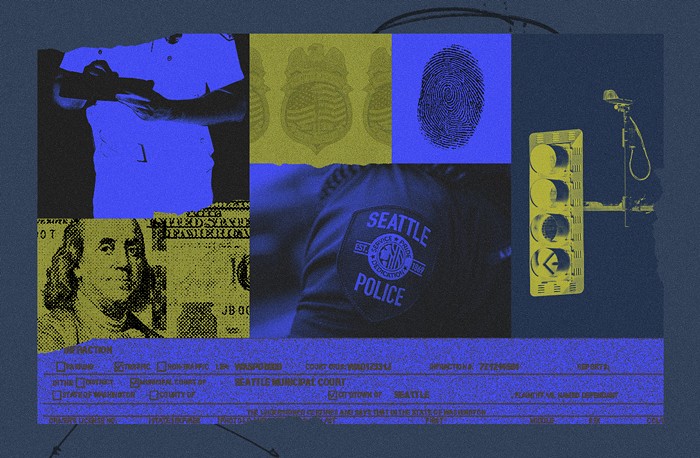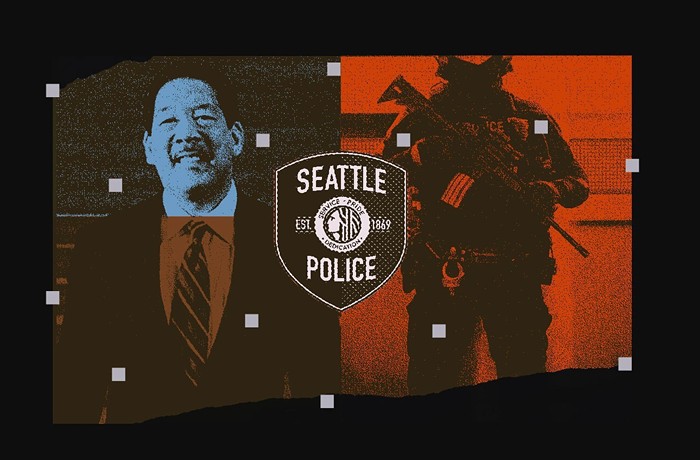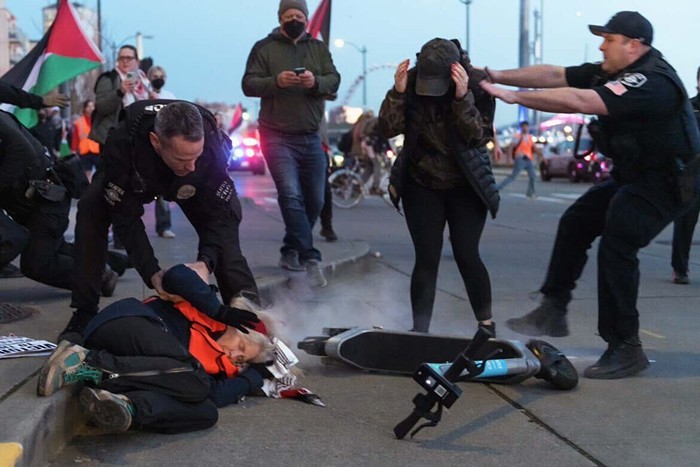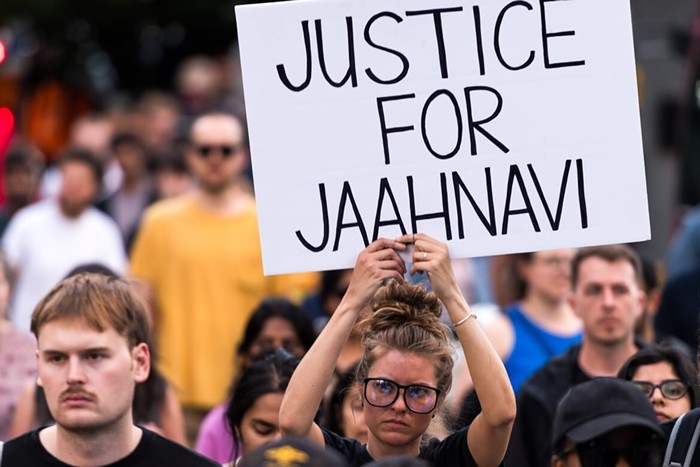Last month, a man with a hammer randomly attacked two people outside the Beacon Hill light rail station. At the time of this writing, the suspect remains at large, even after news outlets plastered his face all over their front pages.
The surveillance images of the man look familiar to most people who live in the city. We’ve all seen a guy like him wandering the streets of Seattle. Sometimes he’s mumbling incoherently or screaming at no one in particular. Sometimes he’s carrying something that could be a weapon. He’s always angry. In the footage from Sound Transit, you can see other people just ignoring the disheveled, disturbed man standing next to them with the hammer. That’s how mundane this sight is.
When I heard about this story, I couldn’t help but think about the time I suffered an unprovoked assault.
A History of Violence
As I walked to the gym one evening, I saw a man coming from the other direction. He had a hostile look in his eyes, so I moved aside to give him some space. Without a word, he punched me. The blow didn’t hit that hard, but it took me by surprise and I fell down sideways. He kept walking. The attack busted my chin open, leaving me with a scar and a $4,000 emergency room bill I couldn’t pay.
Conservatives who stumble across this story will probably feel some schadenfreude at the thought of a “defund” activist victimized by a violent crime, just like the ones who celebrated the killing of Ryan Carson in New York last week. They might fill up the comments section with banal, predictable lines like, “You got what you wanted” or “Keep voting Democrat!” But my attack happened in February 2020. George Floyd was still alive. A council majority hadn’t yet nominally voiced support for the Defund movement, and the Seattle Police Department budget sat at $409 million, an all-time high.
What’s more, the guy hit me in one of the most heavily policed parts of the city. He punched me on the sidewalk along NE 45th Street, a block away from my old apartment. In fact, a random stranger struck me in that exact spot less than a year earlier. When I say “exact spot,” I mean literally 15 feet away. In June of 2019, an agitated, shirtless man apparently under the influence of some kind of stimulant accosted me for cash on the sidewalk outside the Petco. When I told him I didn’t have any, he popped me in the mouth with a little drawstring backpack, busting my lip. Then he just walked off.
Then again, police violence traumatizes me as much as these random attacks on the street. Back in Texas, Austin police hogtied me like a calf and hurt my ankle so badly I limped for days. Once, a cop cuffed me so hard that my wrist bled. I also spent much of 2020 breathing toxic gas and dodging blast balls.
When I lived in the University District, I saw two things everywhere at all times: people with untreated mental illness and cops. Given my history, neither group makes me feel safe. When I see people in crisis on the street—and I see them often—I feel a mixture of fear and deep sympathy. If I were a religious man, I might say, “There but for the grace of God go I.”
Well, I have gone there, and somehow I’ve made it back. As someone with bipolar disorder who has had severe, debilitating manic episodes, I’ve been the person on the bus saying strange, incomprehensible things. I’ve seen people smile nervously or avert their eyes, trying to pretend I don’t exist.
I don’t know if there’s a God above, so I can’t rightly say if His grace is what keeps me from returning. However, I can say there’s something that separates me from all those desperate, angry people wandering the streets: care.
I have family and friends who take care of me when I’m unwell. I have access to doctors, medications, and insurance, so I can go to the hospital if necessary. The man who attacked those people outside the light rail station clearly didn’t have these things, and it was heartening to see one of the victims acknowledge that fundamental truth.
Sixty-three-year-old Elvia Salas Buenrostoro, who suffered a concussion and three broken ribs, told local news: “I feel very sorry for the state he was in. If this happened to another person, I’d say punish the attacker. No, I don’t have that in my heart because I think that he–I don’t know who he is, who he might be–but I think that he has something very big in his mind, or in his heart that made him do this.”
Her call for compassion spurred bemused scoffing from trolls on social media. One user joked, “Guess it was a blow to the head.” Another wrote, “Chances are he's never faced real punishment, which is why he did it.”
For some, the idea of an assault victim demanding anything other than more cops and harsher penalties seems unimaginable. Those same people will deride any alternatives as bleeding-heart liberal naivety, but they’re misguided. Police and prisons cannot solve random violence rooted in untreated mental illness.
When You Only Have a Hammer
Like the hammer used to assault Salas Buenrostro, policing is simultaneously a tool and a weapon. Policymakers design police for a specific purpose, but they end up using them as a Swiss army knife to fix various social problems. Increasingly, mayors and chiefs use them to manage the results of a mental health care system that has failed catastrophically.
But the hammer of policing cannot heal people; it can only harm and kill them. This tool cannot lift people from despair and restore them to a normal life; it can only drive them into a hole, fixing them into place. Sometimes, it hammers people until they are bent and broken.
Self-styled “reasonable” people often advocate for the “common sense” solution of locking up everyone accused of a crime, a far more pie-in-the-sky idea than even the wildest proposals from the wokest, pink-haired Evergreen State College sophomores they deride. While imprisoning the mentally ill might sound like an easy fix to some, warehousing them in jails and in asylums costs lots of money, and the county lacks the capacity to do it.
After the imminent closure of one of the state’s largest for-profit mental health facilities, King County will have fewer than 400 involuntary treatment beds at its disposal. About one-third of the county’s homeless population experiences some form of mental illness. That’s roughly 2,300 unsheltered homeless people, which works out to six times the number of treatment beds. Jail space is even more limited. The county’s largest jail holds 1,700 beds, and it’s constantly overcrowded and routinely forced to bus its inmates to other jails.
Even if the county had the capacity to incarcerate or involuntarily commit every unsheltered person with a mental illness, they’d have to shred the Constitution to actually do it. Only a fraction of that population meets the strict criteria for involuntary commitment. Also, it’s unconstitutional for police to arrest every visibly unwell person carrying a baseball bat, a hammer, or even a gun unless they’ve threatened someone with it.
When someone with a mental illness commits a crime like the hammer attack in Beacon Hill, local news outlets inevitably trot out their rap sheets, driving their audiences to the conclusion that the legal system could have prevented these horrific acts if the liberal “hug-a-thug” judges had only meted out more draconian punishments to these “career criminals.” These lists of crimes do show the failure of the criminal legal system, but not in the way some might think.
Take, for example, Alexander Jay, a man currently undergoing competency restoration while awaiting trial for a string of violent crimes. On a single night, Jay allegedly pushed a nurse down a flight of stairs and stabbed another woman at a bus stop. Prosecutors later charged him with the murder of a homeless man. While Jay’s criminal record reached back to 2000, he wasn’t convicted of a violent crime until he caught a charge for a misdemeanor domestic violence assault six years ago.
His earliest offenses were petty: theft, drug possession, taking a vehicle without consent, burglary, etc. In other words, they were the kinds of crimes a mentally ill person who had a hard time keeping himself employed might commit. These crimes occurred in California, which used mandatory minimum sentencing until 2021, so he undoubtedly did time. According to court documents, Jay had no convictions between 2011 and 2017, when he was convicted for fourth-degree DV assault. He likely spent much of that time incarcerated or in a mental institution.
Cops and courts have been a constant presence in Jay’s life for more than two decades, but these institutions failed to prevent the harms he later inflicted. If anything, the repeated interventions of the criminal punishment system made these outcomes more likely. The effect of incarceration on mental health is well-documented. People who go into jails relatively healthy come out the other side traumatized and barely functional. Those with preexisting mental health conditions are further destabilized and find it even harder to adjust on reentry. Many end up homeless, jobless, and in a state of rapid decay. Some wind up wandering the streets of Seattle with weapons in their hands.
The Punitive Approach Isn’t Working
The Mayor’s so-called public safety approach appears to have worsened the problem of random violence. Following a nationwide trend, homicides spiked in 2020 but fell 19 percent in 2021, the only year in decades when the police budget faced even modest cuts. When “law-and-order” candidates Bruce Harrell, Sara Nelson, and Ann Davison took office in 2022, SPD’s budget and the murder rate rose again.
With the number of homicides now approaching 1990s levels, it’s a good time to question whether the Mayor’s policies are having their intended effects. It’s fair to assume that the almost daily encampment sweeps contribute to random violence rather than mitigate it. The City constantly shuffles around hundreds of people with untreated mental illness, robs them of any semblance of stability, and exacerbates their conditions. Without a consistent place to lay their heads, it’s hard for outreach workers to locate them and direct them to resources. The lack of somewhere to stay and rest forces them to ride around on buses and on the Link all day in an increasingly hostile and agitated state. Should we be surprised when those pushed to the breaking point by nonstop state violence finally snap?
Mayor Harrell’s preferred “solution” to this problem is more cops, but the thing about random violence is that it’s random. SPD’s SeaStat modeling and overpaid crime analysts cannot predict where and when it will occur.
For instance, at Harrell’s direction, the department deployed a surge of officers downtown. The West Precinct was one of two areas that saw decreased response times in 2022, a reflection of increased staffing. But since January of 2022, two homicides have occurred downtown in view of at least one SPD officer. One of those was also a hammer attack. In the other, someone bludgeoned a man to death with a metal pole. A third killing, the sensationalized shooting of Eina Kwon, occurred in a sector that police heavily augment using overtime. That attack was also unprovoked and likely rooted in mental illness.
The Path to Actual Public Safety
It’s hard to talk about crimes like these without contributing to the stigmatization and criminalization of mentally ill people, who are far more likely to be victims than perpetrators of violent crime and 16 times more likely to die at the hands of the police. Nevertheless, it’s critical to understand the role mental illness plays in random violence in order to realize the true path to public safety.
The left and the right don’t have much common ground, but there’s a broad consensus that it’s bad for people to be walking the sidewalks in crisis. We can all agree that it would be better for people not to come home to find a fully clothed man in their bathtubs. We’d all prefer fewer tossed toddlers and fewer dunked joggers. But no amount of cops and courts can make that happen.
Those people out in the streets got where they are because they have no one to care for them, and there was no social safety net to catch them when they fell through the proverbial cracks. If we address that problem, then we solve the problem of random violence.
Instead, our city leaders plan to double-down on the failed strategy of cops, sweeps, and criminalization. Mayor Harrell aims to hire 500 more cops in the next few years. The average gross pay of a patrol officer in 2022 was $155,000. So, factoring in future raises, meeting the Mayor's goal would mean adding more than $100 million to the SPD budget. The City could fund the entire 2022 payroll of the Human Services Department (HSD) more than three times over with that amount. In fact, the entire HSD payroll costs less than SPD’s overtime budget. The City paid $9.5 million for around 140 HSD counselors at an average gross salary of $67,500, so we could hire 1,400 case workers for the price of 500 cops.
That’s way more people than necessary, but it’s a good illustration of budget choices facing officials. The City could at the very least triple or quadruple its human services staff while simultaneously scaling up housing and treatment. The average City case manager maintains a massive caseload of 80 to 100 clients. Cutting that number down to 20 or so would reduce high turnover and allow the kind of one-on-one care needed to actually get people off the street and keep them off. Early intervention can keep people with mental illness from decompensating to the point where they pose a threat to others.
Ultimately, policy decisions determine the number and frequency of these random attacks. Every year, come budget season, City leaders make a choice: care or cops. One path actually gives us a chance of improving public safety, and the other leads to more violence. Right now, the City is choosing violence.



















